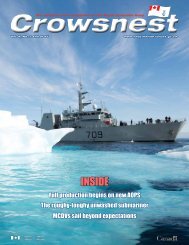You also want an ePaper? Increase the reach of your titles
YUMPU automatically turns print PDFs into web optimized ePapers that Google loves.
esources) <strong>the</strong>re will be continued growth in <strong>the</strong> number <strong>of</strong> larger ships, with those capable <strong>of</strong><br />
carrying greater than 7,600 TEUs growing six times faster than smaller vessels. 49<br />
Table 1: World Container Fleet Development, 1990–2016 (in ‘000s TEUs).<br />
Source: Ocean Shipping Consultants, Container Traffic Forecast Study – Port Metro Vancouver,<br />
June 2014 [www.robertsbankterminal2.com/wp-content/uploads/Port-Metro-Vancouver-<br />
Container-Traffic-Forecast-Ocean-Shipping-Consultants-June-2014.pdf], p. 105.<br />
Seaborne trade is also a motor for national <strong>and</strong> regional economies. <strong>The</strong> continuing growth <strong>of</strong><br />
containerization <strong>and</strong> <strong>of</strong> energy exports will lead to <strong>the</strong> fur<strong>the</strong>r development <strong>of</strong> new ports <strong>and</strong> will<br />
create pressure—economic <strong>and</strong> political—for <strong>the</strong> upgrade <strong>of</strong> established ones. Indeed, a failure to<br />
keep pace with both <strong>the</strong> increase in <strong>the</strong> size <strong>of</strong> container ships <strong>and</strong> <strong>the</strong> volume <strong>of</strong> traffic risks<br />
ships looking to dock elsewhere with economic consequences for established populations. As<br />
seaborne trade is a driver <strong>of</strong> economic expansion, it has led to extensive investments in<br />
infrastructure along coasts <strong>and</strong> within market centres inl<strong>and</strong>. 50 Consequently, <strong>the</strong>re has been a<br />
snowballing <strong>of</strong> port upgrades <strong>and</strong> expansion leading to <strong>the</strong> situation where half <strong>of</strong> <strong>the</strong> world’s<br />
wealthiest cities are ports. 51<br />
China, in particular, has benefitted from this approach. Since 2000, Beijing has invested heavily<br />
in port infrastructure to link inl<strong>and</strong> cities with global markets upon which <strong>the</strong> country’s economic<br />
development depends. 52 As a result, nine <strong>of</strong> <strong>the</strong> 25 <strong>of</strong> <strong>the</strong> world’s busiest ports are currently found<br />
in that country, some <strong>of</strong> which were purpose-built for containerised trade (see Table 2). As an<br />
indicator <strong>of</strong> <strong>the</strong> global economic transformation that has taken place <strong>and</strong> is ongoing, until 2002<br />
<strong>the</strong> distinction <strong>of</strong> being <strong>the</strong> busiest port belonged to Rotterdam: today that ranking is held by<br />
Shanghai. O<strong>the</strong>r countries have acted similarly to that <strong>of</strong> China in modernising <strong>and</strong> exp<strong>and</strong>ing <strong>the</strong><br />
capacity <strong>of</strong> sea ports, such as <strong>the</strong> US in its development <strong>of</strong> west coast ports. <strong>The</strong> largest <strong>of</strong> those<br />
being Los Angeles <strong>and</strong> Long Beach; however, each h<strong>and</strong>le approximately one half <strong>of</strong> <strong>the</strong> volume<br />
49 Lloyd’s Register Group et. al., Global Marine Trends 2030, p. 81. Some container ships now being built<br />
are capable <strong>of</strong> carrying 20,000 TEUs.<br />
50 Transportation networks are not a sufficient condition for economic <strong>and</strong> social development. However, a<br />
lack <strong>of</strong> infrastructure that links a region to a transport network will have a significant retarding effect on<br />
economic growth. This argument is made in Jean-Paul Rodrigue, <strong>The</strong> Geography <strong>of</strong> Transport Systems,<br />
Third Edition (Routledge: London, 2013), p. 229.<br />
51 Lloyd’s Register Group et. al., Global Marine Trends 2030, p. 32.<br />
52 Hoovestal, Globalization Contained, p. 58.<br />
DRDC-RDDC-2016-R085 11




